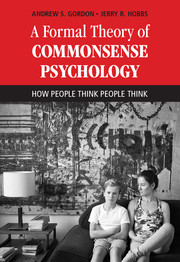Book contents
- Frontmatter
- Contents
- Part I Commonsense Psychology
- 1 Commonsense Psychology and Psychology page
- 2 Commonsense Psychology and Computers
- 3 Formalizing Commonsense Psychology
- 4 Commonsense Psychology and Language
- Part II Background Theories
- Part III Commonsense Psychology Theories
- Appendix A First-Order Logic
- References
- Index
1 - Commonsense Psychology and Psychology page
from Part I - Commonsense Psychology
Published online by Cambridge University Press: 01 September 2017
- Frontmatter
- Contents
- Part I Commonsense Psychology
- 1 Commonsense Psychology and Psychology page
- 2 Commonsense Psychology and Computers
- 3 Formalizing Commonsense Psychology
- 4 Commonsense Psychology and Language
- Part II Background Theories
- Part III Commonsense Psychology Theories
- Appendix A First-Order Logic
- References
- Index
Summary
EXPLAINING THE BEHAVIOR OF TRIANGLES
In 1944 Fritz Heider and Marianne Simmel published the results of a novel experiment conducted at Smith College in Northampton, Massachusetts. In “An experimental study of apparent behavior” Heider and Simmel (1944) prepared a brief film depicting the movements of a two triangles and a circle in and around a shape made to look like a room with a door. The film was shown to 114 undergraduate women at Smith College divided into three experimental groups. In the first, subjects were given the general instruction to “write down what happened in the picture.” In the second, subjects were instructed to interpret the movements of the figures as actions of persons and to answer ten questions in a written questionnaire. The third group was shown the film in reverse, by running the filmstrip backwards through the projector, and asked a subset of the same questions.
The Heider–Simmel film, which is today readily viewable on online video websites, is not particularly remarkable as a piece of animated cinematography. Compared to Walt Disney's films of the same era, including Pinocchio, Fantasia, and Bambi, the film must have appeared anachronistic even to the original Smith College subjects. Each frame in the film was produced as a photo of geometric shapes cut from cardboard and placed on a horizontal translucent-glass plate illuminated from above. The careful placement of the shapes in each frame created a narrative stream of events, evidenced only by the silent trajectories of each shape and its position in relation to the others. As expected, the subjects in the three experimental groups interpreted these events as a coherent narrative and described them in terms of the interrelated behaviors of three intentional characters, in and around a room defined by four walls and a door. Somewhat surprising is the degree to which these descriptions attributed mental states to these nondescript shapes. Heider and Simmel provide the following as representative of the descriptions produced by the first experimental group:
A man has planned to meet a girl and the girl comes along with another man. The first man tells the second to go; the second tells the first, and he shakes his head. Then the two men have a fight, and the girl starts to go into the room to get out of the way and hesitates and finally goes in.
- Type
- Chapter
- Information
- A Formal Theory of Commonsense PsychologyHow People Think People Think, pp. 3 - 16Publisher: Cambridge University PressPrint publication year: 2017

